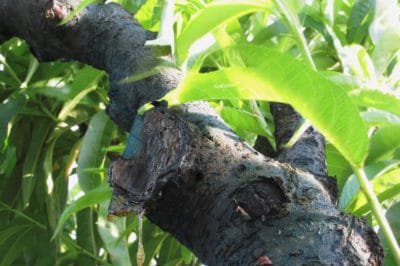Identifying Peach Tree Borer
The larval stages of the peach borer spend their lives hidden under the bark near the base of the tree and just below the soil line. Larva emerge from eggs typically laid in May and June, and the larva immediately move into the bark of the tree through cracks and wounds in the surface.
Look for wet areas on the bark at the base of the tree and a gummy, translucent substance oozing from the bark. If you look closely, you will see small fragments of bark and wood dust trapped in the gum, indicating the presence of peach borer.
Eggs of the peach tree borer are oval and orange or yellow. Eggs are most often spotted on the truck of the tree near the base.
The larvae are white with a black head in their early life. They later turn brown with light and dark bands and are approximately ½ inch (1.25cm) in length.
The pupae of peach tree borer are between ¼ and 3/8 inches (6.3 to 10mm) in length and are brown. The pupae shelter in cracks in the tree bark.
The larva turn into adults about one month after going through the pupal stage. Pupal skins at the base of the tree is another sign of an infestation.
The adult moths emerge in mid to late June over a period of two to three weeks. Adults are approximately 1/3 inch (7.6mm) in length, dark in color with an orange or yellow band around their mid-section.
Treating and Preventing Peach Tree Borer
Insecticidal sprays containing permethrin can be used to control this pest. Organic methods of control include:
- Remove nearby wild cherry and plum trees which can harbor the pest.
- Avoid damaging the base of the tree when mowing or using a weed-eater.
- Spray neem oil or citrus extract sprays on the base of the tree and the soil near the trunk up to about 12 inches (30cm) high when adults first emerge to prevent egg laying.
- Use pheromone traps to disrupt mating and to check for the presence of adult moths.
- Place cedar chips around the base of the tree to discourage this pest.
Stressed trees are more susceptible to an infestation. Keeping trees healthy by planting them in well-drained soil and watering them correctly is one of the best ways of warding-off an infestation of peach tree borer.
